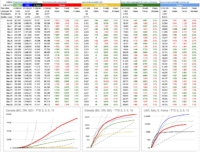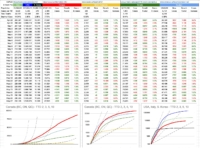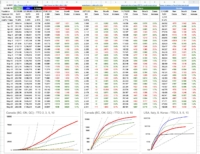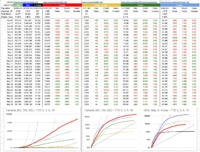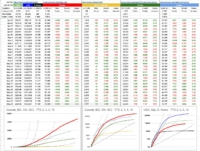Share...
Day 73 – May 28, 2020
The whole “too many chefs in the kitchen” or “too many cooks spoil the broth” — the thought behind it applies to pretty-much everything in life. Certainly, from experience… having been both the guy being told what do do — and the guy telling others what to do — I strongly believe in it.
One key to success — again, in many facets of life… and I’ve said it often… surround yourself with capable people and let them do their thing. This means understanding that they will do things… differently. Compared to what you would’ve done, it might be better or it might be worse… but it’ll certainly be different. The thing is, as long as you were right — that they were the right person for the job, capable of doing it — it should turn out alright. And this doesn’t mean that person is the one who does everything; it’s just clearly understood that the entire thing, no matter what it is… they answer to it. They can delegate jobs, hire extra people, whatever… but it’s up to them.
The chef/kitchen thing is a great example, actually. One can only imagine the chaos a large-scale kitchen would endure if multiple bosses were screaming out orders. There is a hierarchy, and at the top of it is the head chef. There may be a sous-chef, a pastry chef, a number of others… and multiples thereof. But there is a well-defined tip of the pyramid.
On one particular day… around 20 years ago, three former premiers of this province were all in Provincial Court on the same day. A complete coincidence… Bill Vander Zalm with his Fantasy Gardens scandal, Mike Harcourt with his BingoGate scandal, Glen Clark with his casino-license-for-deck-repairs scandal…. all there for different reasons, but all there to face the music with respect to abusing the public trust in some way, scandals that drove all of them out of office. That’s a SoCred and two NDPers, but corruption crosses all party lines. Subsequent to that came Gordon Campbell, Liberal, ultimately driven from office by the BC Rail Scandal. What is it with B.C. and our elected premiers? Scandalous.
I guess I’m relieved that the guy in charge these days isn’t some wild-west shoot-from-the-hip sort, doing whatever he pleases for personal gain. That … [Continue Reading]
Day 72 – May 27, 2020
As per usual, researching things leads to interesting facts. What do you think is the driest place on earth? I always thought it was the Atacama Desert in Chile, but turns out it’s in second place… to an area in Antarctica where it hasn’t rained in somewhere between 2 and 14 million years. You’d think you could safely assume there isn’t much life around there… but there actually is. Way underground, inside the rocks… bacteria that feed on iron, potassium and sulfur. And, for those bacteria that aren’t doing keto (or cheat a bit sometimes), carbon.
I can attest to the dryness of the Chilean desert because I lived there. In the driest parts… the further north you go, the drier it is. Some weather stations record 1mm of precipitation a year. Some have never recorded any.
Where I lived, Copaipó, a bit further south than that, rain was rare enough that it was talked about like a big event… The Big Rain of ’85. Part of the reason it’s such a big deal is that every single place around there spends zero on mitigating it. No drains, no gutters. So when it rains, it’s an unmitigated disaster. Everything floods. Everything… because there’s nowhere for the water to go. People will be sweeping water from their homes into the street. The streets are a flooded mess of mud. Eventually, often sooner than later, the sun comes out and it all evaporates away, leaving the usual Martian landscape. And a huge mess to clean up.
Though, it should be noted, and this is super-cool because it’s so rare… there is some version of suspended life under the Atacama desert — seeds just waiting for their one chance. They wait decades for their one big moment… and then it comes… and the desert flourishes with life for a few hours — an incredible array of colour, albeit briefly. That happened in 2015, and it was spectacular. But also, it was more rain than they’d possibly ever had… almost an inch of water fell… and caused massive flooding and landslides, killing 25 people and leaving thousands homeless.
The ability to count on no rain leads to some interesting possibilities. Very few people had a dryer; clothes-lines everywhere. And.. there was a road up in the mountains made … [Continue Reading]
Day 71 – May 26, 2020
There’s an interesting footnote about that Spanish Flu pandemic of 1918… which is the age distribution of deaths. For COVID-19, the median age of mortality is… well, it’s high. Depending where you look, it’s almost always north of 80. The younger you are, the better your chances… all the way down to zero, where except in extremely rare cases, often associated with other contributing factors, pretty-much anyone under the age of 20 looks safe from developing any serious symptoms.
A lesser-discussed pandemic is the Russian flu, which ran over a period of 4 years, peaking around 1890… and ultimately killing more than a million people worldwide. Its mortality profile is similar to COVID-19 in that it was far more dangerous for the elderly. But also, a big difference… is that it also killed a lot of very young people. The mortality rate for ages 0 to 10 was similar to those somewhere in the 40-60 range. The 10-30 age range was the least affected… and those over 70 were more than 20x likelier to die than that 10-30 group.
The 1918 pandemic hit the young people the hardest, a puzzling question that’s still being discussed, and there are very different ways of approaching it. The worst age to be for that pandemic was 28 — that was the highest-mortality age group. One common thought is that those who survived the 1890 pandemic built immunity, and were far less affected in 1918. But another interesting analysis starts with some simple math… 1918-28 = 1890. Indeed, those who survived the 1890 pandemic as infants… whether just born or perhaps still in utero — they were the ones hardest hit 28 years later.
To further confuse the issue, while it’s established that 1918 was without a doubt influenza (H1N1), there are some theories that 1890 wasn’t actually a flu, but a coronavirus… which obviously means that the theory of acquired immunity for older people can’t be correct, and that perhaps some drastic effect on the immune system of infants took place during a critical time of development.
Such are the sorts of things I learn when I fall into the Google spiral of doom… setting out to research something, and winding up very far away… and you all know how that can go… even here on … [Continue Reading]
Day 70 – May 25, 2020
Yesterday’s post was met with a wide range of reaction, and the questions and comments lead me to think a bit of clarification and more detail would be appropriate. Some of those comments came from Swedes themselves, a little bit upset at being painted somewhat ruthlessly; to clarify, I’m speaking about leadership and their policies; not the general population, many of whom don’t agree with the official policy in the first place. And to also clarify, I’m not implying their leadership and epidemiologists are evil. They simply came up with a strategy, and it’s not working as they’d hoped. So, här är del två…
I first wrote about Sweden on April 10th… more than 6 weeks ago. I welcome you to scroll down and find it — it’s a pretty good summary of where things stood at that point, what measures where (and weren’t) in place, and what I thought of the whole idea. And sure, “What do you know?” is a fair question to ask of me… especially 6 weeks ago. We’re all continually asking the question of each other, and hopefully learning something. That same article also mentions a famous letter signed by more than 2,000 Swedish doctors, scientists and professors… the contents of which can be summarized succinctly as it relates to government policy (which hasn’t changed): “They are leading us to catastrophe”.
First of all, let’s clarify exactly what is meant by herd immunity.
Herd immunity is where enough people of a population are immune to the extent that the infection will no longer spread within that group. The more infectious a disease, the higher that percentage has to be. For example, mumps is very contagious. It has an Rø of 10 to 12, meaning every infected person will infect, on average, 10 to 12 others. Left unchecked, this would lead to 95% of the population getting infected. After that, the population can be considered to have acquired herd immunity, and the other 5% will inherit the benefit of that… because at that point, there’s no one left to catch it from. Measles has similar numbers. That particular herd-immunity threshold is very high, and can only be reached via vaccination because allowing everyone to catch either of those horrible diseases is not an option. And these days, completely preventable.
With … [Continue Reading]
Day 69 – May 24, 2020
No updated numbers for B.C. today, so, as usual… I’ll make an intelligent guess and fix it tomorrow.
So let’s talk about yesterday’s numbers, and let’s begin with the old “5 blind guys and an elephant” parable. The premise of it is straightforward… these 5 guys have never encountered an elephant, and each reach different conclusions about the different parts of the elephant that they touch. The guy who grabs a leg describes it like a tree trunk. The guy who grabs the tail describes it as a rope. The guy who grabs an ear describes it as flat and floppy. The other two guys… one grabs a tusk, the other grabs the trunk. Their interpretation and discussion with each other is outside the scope of this post; we’ll leave Freudian experts to discuss their conclusions.
The moral of the story actually changes, depending on what lesson you’re trying to teach. Maybe that vastly differing opinions are all justified when talking about the same subject, like someone else’s opinion is just as valid. Maybe that sometimes, we’re fighting about the same thing. Maybe that we need to question our method of questioning. In some versions, the guys aren’t blind; just in the dark. But once they’ve “seen the light”, they all agree.
Let’s go with something like that… the guys aren’t blind, just initially blindfolded… but were convinced by their first impressions, especially because they went around telling everyone, and in doing so, convincing themselves that their version was “the most correct”. Indeed, even after the blindfolds were lifted, and they could see the big picture, they still clung to their beliefs… perhaps since they were already so invested. And, to add a bit more to it… once they could see, they realized that they were actually in an elephant park… with lots of different elephants. And, all of the elephants had been given names… of places, like in that series “Money Heist” (side note: watch Money Heist, and watch it in Spanish, with subtitles… incredibly good.. it’s on Netflix).
So these elephants… there’s one off in the distance… her name is New Zealand. She’s tiny, but looks very healthy. There’s one called Canada, who is really big and, for the most part, looks ok — parts of him looks much healthier than other … [Continue Reading]


